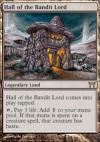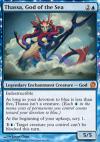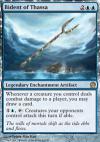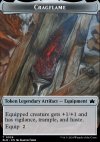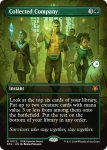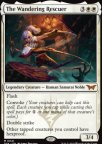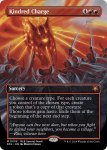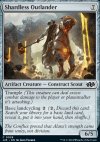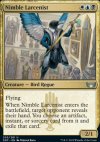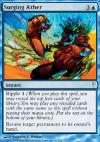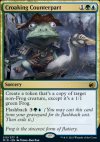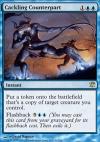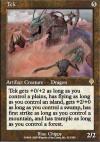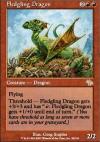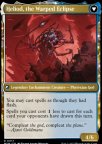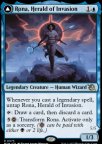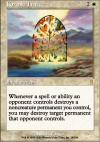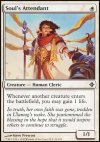|

MV anecdotes
| 4847 anecdotes trouvées |   |
Les cartes Hall of the Bandit Lord et Tenza, Godo's Maul représentent respectivement le repaire et l'arme de Godo, Bandit Warlord.
Toutes ces cartes sont illustrées par Paolo Parente.
Toutes ces cartes sont illustrées par Paolo Parente.
Thassa, God of the Sea ne possède plus son Bident of Thassa car Kiora, the Crashing Wave le lui a dérobé sur Theros avant de transplaner sur Zendikar et d'y combattre les Eldrazis.
Le texte d'ambiance de Bident of Thassa (pour les rééditions avec l'illustration alternative figurant Kiora) fait d'ailleurs référence à ce larcin.
Source
Le texte d'ambiance de Bident of Thassa (pour les rééditions avec l'illustration alternative figurant Kiora) fait d'ailleurs référence à ce larcin.
Source
La carte Arni Metalbrow représente Arni Brokenbrow, après l'invasion phyrexiane du Multivers.
Ce dernier, leader des Tuskeri (voir cette anecdote), et l'un des meilleurs combattants de Kaldheim, était célèbre pour avoir vaincu un troll en combat singulier (Arni Slays the Troll) - et avoir gardé une corne brisée incrustée dans son front, après lui avoir asséné un coup de tête.
L'un des premiers défenseurs de Kaldheim lors de l'invasion phyrexiane, il semble qu'Arni ait récidivé face à ces nouveaux ennemis - et se retrouve maintenant avec deux cornes plantées dans le crâne... De quoi avoir de nouvelles histoires à raconter pour se vanter...
Ce dernier, leader des Tuskeri (voir cette anecdote), et l'un des meilleurs combattants de Kaldheim, était célèbre pour avoir vaincu un troll en combat singulier (Arni Slays the Troll) - et avoir gardé une corne brisée incrustée dans son front, après lui avoir asséné un coup de tête.
L'un des premiers défenseurs de Kaldheim lors de l'invasion phyrexiane, il semble qu'Arni ait récidivé face à ces nouveaux ennemis - et se retrouve maintenant avec deux cornes plantées dans le crâne... De quoi avoir de nouvelles histoires à raconter pour se vanter...
Source a écrit :
[...] the troll lay flat on his back, one of his tusks snapped off at the root. Above him, victorious and bloody, troll-bone embedded in his forehead, was Arni Goatleaper—only his name was Goatleaper no longer.
Cragflame, l'épée de Mabel, Heir to Cragflame a été fabriquée à partir d'un croc de Wildsear, Scouring Maw.
L'extrait traduit en français :
Source 2 (true and false edges)
Source 1 a écrit :
[...] this weapon was crafted from a massive tooth, honed down to a size manageable for little folk. The sigil-etched blade curved, sharpened on both the true and false edges, tapering to a wicked point. The hilt was simple, cord-wrapped, while the pommel was carved into the shape of a dancing flame.
The sword once belonged to Lily of the Valley herself, so the story went, formed from the fang of the Wildfire Wolf that nearly destroyed Bloomburrow. [...]
The sword once belonged to Lily of the Valley herself, so the story went, formed from the fang of the Wildfire Wolf that nearly destroyed Bloomburrow. [...]
L'extrait traduit en français :
Citation :
[...] cette arme était fabriquée à partir d'une dent massive, affutée jusqu'à une taille gérable pour les petites gens. La lame gravée d'un sceau était courbée, aiguisée sur les deux bords, s'effilant jusqu'à une méchante pointe. La poignée était simple, entourée d'un cordon, tandis que le pommeau était sculpté en forme de flamme dansante.
L'épée appartenait autrefois à Lily de Vallée elle-même [l'ancêtre de Mabel], ainsi que racontait l'histoire, formée à partir du croc du Wildfire Wolf qui a presque détruit Bloomburrow. [...]
L'épée appartenait autrefois à Lily de Vallée elle-même [l'ancêtre de Mabel], ainsi que racontait l'histoire, formée à partir du croc du Wildfire Wolf qui a presque détruit Bloomburrow. [...]
Source 2 (true and false edges)
Sur l'illustration de Borja Pindado pour la carte Collected Company, de l'édition Special Guests - Duskmourn: House of Horrors, on peut apercevoir les protagonistes de la Storyline de l'édition, de gauche à droite : Niko, Light of Hope, The Wandering Rescuer, Tyvar, the Pummeler, Kaito, Bane of Nightmares et Zimone, All-Questioning.
Sur l'illustration de Milivoj Ceran pour la carte Kindred Charge, de l'édition Special Guests - Bloomburrow, on peut voir un Sunspine Lynx.
La construction qu'on peut voir sur la carte Shardless Outlander est le même modèle que Golos, Tireless Pilgrim !
L'illustration de la carte Commander's Plate, de l'édition Secret Lair - Angels: They're Just Like Us but Cooler and with Wings, représente l'armure portée par Lyra Dawnbringer.
Sur l'illustration de la carte Ajani's Chosen, on peut voir à gauche la Wild Nacatl.
Ces deux cartes sont illustrées par Wayne Reynolds.
Ces deux cartes sont illustrées par Wayne Reynolds.
Sur l'illustration de la carte Nimble Larcenist, on peut voir dans un tableau en arrière-plan à droite l'illustration de Luxior, Giada's Gift.
Ces deux cartes sont illustrées par Volkan Baga.
Ces deux cartes sont illustrées par Volkan Baga.
Sur les illustrations des cartes Deserted Beach, Shipwreck Marsh, Haunted Ridge, Rockfall Vale et Overgrown Farmland, de l'édition Innistrad: Midnight Hunt, on peut apercevoir un Crossroads Candleguide, jouant son rôle de guide et indiquant le chemin. Celui-ci se retrouve également sur les illustrations des versions Borderless de ces terrains.
Les cinq cartes Surging Sentinels, Surging Aether, Surging Dementia, Surging Flame et Surging Might, de l'édition Coldsnap, forment un cycle appelé "Surging". Ce sont les seules cartes avec la capacité Remous (hormis la Thrumming Stone qui permet de la conférer à tous les sorts que vous lancez).
Il semblerait que la grenouille représentée sur Croaking Counterpart soit surprise en pleine tentative d'imitation de Rem Karolus, Stalwart Slayer !
Le texte d'ambiance de la carte Croaking Counterpart est une référence parodique à celui de Young Pyromancer, qui est lui-même une référence à une citation de Charles Caleb Colton, souvent attribuée à tort à Oscar Wilde, "Imitation is the sincerest form of flattery". Elle prend tout son sens pour la première carte puisque celle-ci permet de créer un jeton copie d'une créature (qui est de type Grenouille, comme dans le texte d'ambiance).
Source
Source
La carte Croaking Counterpart est une référence à Cackling Counterpart de par son nom, son coût de mana, son effet et le fait qu'elle possède un coût de Flashback, l'ensemble étant équilibré et adapté à la couleur verte selon la color pie.
La carte Scion of Draco est une référence aux cartes Draco et Tek (deux dragons du bloc Invasion), elle reprend à chacune une partie de son nom ou de ses capacités : à la première, son nom, sa capacité d'évasion et sa capacité Domaine qui permet de réduire son coût de lancement ; à la seconde, plus subtilement, sa capacité statique qui offre un bonus de capacités mots-clés aux créatures que vous contrôlez en fonction de leurs couleurs (capacités éventuellement revisitées et adaptées selon la color pie), à la nuance que Tek ne confère ses bonus qu'à lui-même et qu'ils sont fonction des types de terrain de base (dans le même esprit que la capacité Domaine) et non des couleurs.
La carte Fledgling Dragon est une référence à Shivan Dragon de par ses force et endurance et sa capacité de Firebreathing une fois le Seuil atteint ; elle en est en quelque sorte une version plus jeune.
La carte Thundering Chariot est une référence à Chariot of Victory de par son nom et ses capacités mots-clés ; elle en est une version véhicule, sous-type d'artefact plus adapté à son flavor mais seulement introduit avec l'édition Kaladesh, donc postérieurement à l'édition Journey into Nyx.
Source
Source
Les cartes Dimir Guildmage, House Guildmage, Duskmantle Guildmage et Duskmantle, House of Shadow sont un bel exemple de "lore" sur le Plan de Ravnica. En effet, chaque guilde a possédé un Ghildmage différent au fil des éditions (voir cette anecdote, celle-ci et celle-là).
Il y en a aujourd'hui trois versions : la première avec le nom de la guilde, la deuxième avec le nom du "Q.G." de la guilde, qu'on retrouve sur un cycle de terrains (voir cette anecdote), et la troisième avec le type de structure sociale de la guilde.
Ici, c'est la Maison Dimir, basée sur Duskmantle, qui est illustrée.
Il y en a aujourd'hui trois versions : la première avec le nom de la guilde, la deuxième avec le nom du "Q.G." de la guilde, qu'on retrouve sur un cycle de terrains (voir cette anecdote), et la troisième avec le type de structure sociale de la guilde.
Ici, c'est la Maison Dimir, basée sur Duskmantle, qui est illustrée.
Les cinq cartes Heliod, the Radiant Dawn, Rona, Herald of Invasion, Ayara, Widow of the Realm, Etali, Primal Conqueror et Polukranos Reborn, de l'édition March of the Machine, forment un cycle de créatures légendaires pouvant chacune se transformer en Phyrexian avec une couleur alliée.
La capacité déclenchée de la carte Scalelord Reckoner est une référence à celle de la carte Karmic Justice.
La carte Soul's Attendant est une réimpression fonctionnelle de Soul Warden, à la nuance que l'effet de gain de points de vie est optionnel.
La carte Genesis Hydra est une référence à Genesis Wave de par son nom, son coût de mana (à un mana coloré près) et l'effet de sa capacité déclenchée lors de son lancement.
| 4847 anecdotes trouvées |   |






 Avatar: the Last Airbender
Avatar: the Last Airbender Spider-Man / Omenpaths
Spider-Man / Omenpaths Edge of Eternities
Edge of Eternities Final Fantasy
Final Fantasy Tarkir: Dragonstorm
Tarkir: Dragonstorm Aetherdrift
Aetherdrift Foundations
Foundations